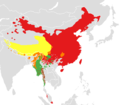ᱨᱮᱫ:Major Sino-Tibetan groups.png
Major_Sino-Tibetan_groups.png (᱔᱗᱑ x ᱔᱑᱔ pixels, file size: ᱑᱖ KB, MIME type: image/png)
ᱨᱮᱫ ᱨᱮᱭᱟᱜ ᱱᱟᱜᱟᱢ
ᱚᱠᱛᱚ ᱨᱮ ᱞᱤᱱ ᱢᱮ/ᱚᱠᱛᱚ ᱨᱮ ᱨᱮᱫ ᱧᱮᱞ ᱞᱟᱹᱜᱤᱛ ᱞᱤᱱ ᱢᱮ
| ᱢᱟᱹᱦᱤᱛ/ᱚᱠᱛᱚ | ᱴᱤᱯ | ᱡᱚᱠᱷᱟ | ᱵᱮᱵᱷᱟᱨᱤᱭᱟᱹ | ᱠᱟᱛᱷᱟ | |
|---|---|---|---|---|---|
| ᱱᱤᱛᱚᱜ | ᱑᱗:᱔᱑, ᱙ ᱡᱩᱱ ᱒᱐᱒᱑ |  | ᱔᱗᱑ × ᱔᱑᱔ (᱑᱖ KB) | Sgnpkd | Korean area is overstated, refine Gansu areas, adding Chinese communities in Malaysia |
| ᱑᱖:᱕᱓, ᱙ ᱡᱩᱱ ᱒᱐᱒᱑ |  | ᱔᱗᱑ × ᱔᱑᱔ (᱑᱖ KB) | Sgnpkd | Extend the range of the Chin, Naga, Switch Jingpho, Kachin into orange, remove Tibetan range in uninhabited areas | |
| ᱑᱖:᱓᱕, ᱙ ᱡᱩᱱ ᱒᱐᱒᱑ |  | ᱔᱗᱑ × ᱔᱑᱔ (᱑᱖ KB) | Sgnpkd | remove Mandarin range in the unhabited desert & south Xinjiang to a more accurate range, adding Mandarin in Yili & Altay, adding the range of the Tujia people | |
| ᱑᱖:᱒᱕, ᱙ ᱡᱩᱱ ᱒᱐᱒᱑ |  | ᱔᱗᱑ × ᱔᱑᱔ (᱑᱖ KB) | Sgnpkd | 1] Repair previous error switch back southern Qiang(not Yi) into orange 2] adding the ranges of the Bai (orange), Nuosu Yi and Naxi people (Lolo), extend range of Tibetan languages to the border of northern and southern Qiang | |
| ᱑᱖:᱑᱖, ᱙ ᱡᱩᱱ ᱒᱐᱒᱑ |  | ᱔᱗᱑ × ᱔᱑᱔ (᱑᱖ KB) | Sgnpkd | Adding southern Yi ranges (see Yi people) switch the Liangshan Yi into green (which is Loloish) | |
| ᱑᱙:᱑᱒, ᱑᱓ ᱢᱮ ᱒᱐᱒᱑ |  | ᱔᱗᱑ × ᱔᱑᱔ (᱑᱔ KB) | Abdcd12312ew | Reverted to version as of 11:29, 2 August 2020 (UTC). There are significant inaccuracies in the current map in manchuria. The Han have an overwhelming majority in the region, in both cities and the countryside. Manchu is quite literally an endangered language. | |
| ᱑᱙:᱕᱘, ᱔ ᱢᱮ ᱒᱐᱒᱑ |  | ᱔᱗᱑ × ᱔᱑᱔ (᱑᱖ KB) | Glennznl | Reverted to version as of 14:36, 22 February 2017 (UTC) Reverted to version before large simplifications | |
| ᱑᱑:᱒᱙, ᱒ ᱚᱜᱚᱥᱴ ᱒᱐᱒᱐ |  | ᱔᱗᱑ × ᱔᱑᱔ (᱑᱔ KB) | Ngguls | Almost no body speaks Tibetan in Xinjiang. Between Xinjiang and Tibet, the vast Qiangtang plateau is uninhabited. | |
| ᱐᱔:᱓᱓, ᱑ ᱡᱩᱱ ᱒᱐᱒᱐ |  | ᱔᱗᱑ × ᱔᱑᱔ (᱑᱕ KB) | Sharouser | Reverted to version as of 15:58, 17 November 2018 (UTC) There were no Sino-Tibetan speakers in Korea or Russia. | |
| ᱑᱓:᱒᱖, ᱒᱗ ᱮᱯᱨᱤᱞ ᱒᱐᱑᱙ |  | ᱔᱗᱑ × ᱔᱑᱔ (᱑᱔ KB) | LenguaMapa | more what is chinese spoken area, mandarin is now majority language in all of inner mongolia and manchuria |
ᱯᱷᱟᱭᱤᱞ ᱵᱮᱣᱦᱟᱨ
ᱞᱟᱛᱟᱨ ᱨᱮᱭᱟᱜ ᱥᱟᱦᱴᱟ ᱡᱚᱱᱚᱲᱠᱚ ᱱᱤᱭᱟᱹ ᱨᱮᱫ ᱨᱮ:
ᱡᱮᱜᱮᱛ ᱡᱟᱠᱟᱛ ᱨᱮᱫ ᱵᱮᱵᱷᱟᱨᱟᱜ
ᱱᱚᱶᱟ ᱨᱮᱫᱠᱚ ᱵᱮᱵᱷᱟᱨᱟᱠᱟᱫ ᱣᱤᱠᱤᱠᱚ :
- bcl.wikipedia.org ᱨᱮ ᱵᱮᱣᱦᱟᱨ
- cdo.wikipedia.org ᱨᱮ ᱵᱮᱣᱦᱟᱨ
- de.wikipedia.org ᱨᱮ ᱵᱮᱣᱦᱟᱨ
- diq.wikipedia.org ᱨᱮ ᱵᱮᱣᱦᱟᱨ
- en.wikipedia.org ᱨᱮ ᱵᱮᱣᱦᱟᱨ
- et.wikipedia.org ᱨᱮ ᱵᱮᱣᱦᱟᱨ
- fa.wikipedia.org ᱨᱮ ᱵᱮᱣᱦᱟᱨ
- fr.wikipedia.org ᱨᱮ ᱵᱮᱣᱦᱟᱨ
- he.wikipedia.org ᱨᱮ ᱵᱮᱣᱦᱟᱨ
- incubator.wikimedia.org ᱨᱮ ᱵᱮᱣᱦᱟᱨ
- lfn.wikipedia.org ᱨᱮ ᱵᱮᱣᱦᱟᱨ
- mg.wikipedia.org ᱨᱮ ᱵᱮᱣᱦᱟᱨ
- ne.wikipedia.org ᱨᱮ ᱵᱮᱣᱦᱟᱨ
- simple.wikipedia.org ᱨᱮ ᱵᱮᱣᱦᱟᱨ
- sl.wikipedia.org ᱨᱮ ᱵᱮᱣᱦᱟᱨ
- sr.wikipedia.org ᱨᱮ ᱵᱮᱣᱦᱟᱨ
- tg.wikipedia.org ᱨᱮ ᱵᱮᱣᱦᱟᱨ
- tr.wikipedia.org ᱨᱮ ᱵᱮᱣᱦᱟᱨ
- ur.wikipedia.org ᱨᱮ ᱵᱮᱣᱦᱟᱨ
- uz.wikipedia.org ᱨᱮ ᱵᱮᱣᱦᱟᱨ
- zh-min-nan.wikipedia.org ᱨᱮ ᱵᱮᱣᱦᱟᱨ
- zh.wikipedia.org ᱨᱮ ᱵᱮᱣᱦᱟᱨ


